Jump to the answer you need...
Everything You Need to Know About a BGE Energy Audit
Often homeowners don't know what a BGE energy audit is or how it can help you understand energy waste in "three-dimensional" ways.
For example, have you ever considered that an incorrectly installed bathroom exhaust fan will cost you more in annual energy waste than perhaps all of the old windows in your house?
Here is what the BGE Home Performance with ENERGY STAR® program can do for you:
1. It can help you avoid choosing the wrong solution to a home comfort problem.
2. An energy audit can help you find practical & often missed ways to reduce your energy bill.
3. A BGE energy audit is a great way to organize your home improvement priority list.
4. It will undoubtedly guide you or someone you know to a more comfortable home.
This article breaks it down for you and shows how getting the audit done can open your eyes to a few unexpected things!
This article also describes the full home energy audit offered through BGE, not the free BGE audit that is quick and designed as a precursor to the comprehensive assessment.
<Back to Top>
Approved BGE Energy Audit Contractor
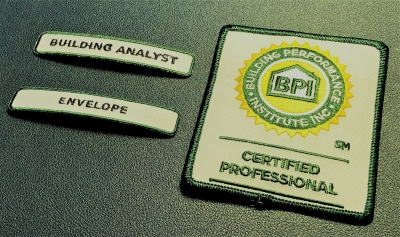
There are only a select few contractors in the state of Maryland that qualify to perform a BGE energy audit within the BGE weatherization program. An approved auditing company in the program has a unique skill set.
Two certifications are critical to understanding the audit process and being accepted into the program. A contractor that carries a Building Analyst certification can identify energy issues. The Envelope Professional designation means that we also know how to fix problems.
Most contractors know how to sell you what you want and install what they sell. BGE energy audit-approved energy firms know how to show you what you need and install it, so it makes a difference.
BGE Audit Google Reviews
Please read what others are saying about their experience.
Hometrust Remodeling
<Back to Top>
A Typical BGE Energy Audit Experience
Hour 1 - Meet & Greet
First, the auditor needs to learn about what is going on with your house and what has you interested in getting the audit done. You can give the auditor a tour of the house. You and your auditor should discuss any details or items of interest you might want to share.
Hour 2 - Auditor Data Collection/ Testing
Every auditor has their style and method. Data collection is a very important part of a home energy audit and a house can be fairly complicated. Typically hour two is spent apart from the technician so that accurate information can be collected through testing and measurements.
Hour 3 - Attic Inspection/ Blower Door Test
Once all information from the key places around your home, including your attic and crawl space, has been collected, the only test left is the blower door test. The blower door test is an excellent opportunity to walk around the house, perform a physical inspection, and review all findings. This way, when reporting is provided, the information in the paperwork will align with what you see around your home on the day of the audit.
<Back to Top>
Why Do You Need a BGE Energy Audit?
A great way to significantly reduce energy waste is to tighten up your home's envelope. When sealing is done correctly, your HVAC runs less, pests have a more challenging time getting in, and you feel more comfortable. Knowing where to look and how to accomplish improving your "building's shell" is the central focus of a BGE energy audit.
A certified energy auditor will investigate areas of your home that typically do not see much "daylight." The dark places and small spaces sometimes yield the most information.
Getting the service done to have a trained pro to check out the attic or crawl space is well worth the small investment of $100!
Get questions answered, such as:
- How much insulation is needed in your attic?
- How do you properly vent your crawl space?
- Should you remove old insulation from your attic?
- What is the best way to seal your crawl space?
- Is spray foam insulation the best solution for your home?
- Why are your windows feeling drafty?
- Should you insulate the walls in your home?
- What areas should you seal to reduce drafts?
Get an energy audit today and ensure your HVAC ducts are not heating and cooling areas of your home that waste a lot of your money & your comfort!
<Back to Top>

What Kind of Service is a BGE Energy Audit?
Not every contractor in Maryland qualifies to perform a BGE energy audit. Improving your home's building shell tightness is not as simple as adding more insulation.
BGE weatherization program energy auditors must be certified as Building Analysts to identify a house's needs. Calculating the number of air changes per hour your house loses uncontrolled to the outside is part of the assessment. Check out examples of interesting things we find tied to air leakage.
A BGE energy auditor evaluates your house as it stands now. The auditor accurately takes a "snapshot" of your home's energy performance and looks around for insulation weaknesses to find easy ways to make improvements.
Watch this attic inspection summary in a common type of home in the BGE territory.
Health and safety testing, pressure readings, and an air leakage test are all data points needed to complete the energy audit. Other evaluations depend on age, symptoms, and preexisting conditions.
<Back to Top>
What does a BGE Energy Audit Test Around Your House?
Health & Safety Testing
Several health and safety tests are performed during a BGE energy audit. You can expect the following:
- Combustion testing of any gas appliances
- Carbon monoxide testing
- Gas line leakage testing
A gas leak was detected and confirmed at this Maryland residence.
Air Flow Testing
Ventilation is essential to healthy living and must be part of the overall plan to improve efficiency.
Take the critical step of scheduling your BGE energy audit as soon as possible! It's a steal at $100!
<Back to Top>
How Can a BGE Energy Audit Give You a Check-In on Your Home's Indoor Air Quality?
Indoor air quality is commonly misunderstood as a number calculated in particles. Instead, it refers to getting fresh air into a home.
A BGE energy audit is a great way to determine your indoor air quality "score" and how to fix any deficits that may exist. A great way to assess indoor air quality is to consider a common misconception.
An excellent carpenter who works around houses every day once said to me during a discussion about air sealing a house:
"Well, gee, don't you need to let the house breathe?"
This comment has a direct tie to indoor air quality. The answer is YES, of course. But, we need to discuss the difference between uncontrolled and controlled "breathing."
Using sophisticated modeling software, data collected during the audit will calculate the required air changes per hour for each inspected home. The assessment looks to tighten a building's shell, therefore calculations are made as the house stands now and projections are calculated if the house is tightened.
The great thing about the BGE energy audit is that you can find out your indoor air quality status now without having to do any additional work. Some houses are too tight before any measures are taken, and the occupants are happy to know there is a deficit and how to remedy the issue. An energy audit consistently delivers solutions that give the homeowner complete control.
<Back to Top>
What does a BGE Energy Audit Look for on the Exterior of Your Home?
A walk around the perimeter of your home by a certified auditor is an essential part of taking a whole-house approach to remodeling. Uncovering issues that have gone unnoticed is an effective way to prioritize your home remodeling projects.
For example, if downspouts are not adequately extended from the home, recommendations on how to remedy the issue will be provided to keep water away from the foundation wall.
Other areas of importance are siding, windows, doors, HVAC, and trim. Looking at ventilation areas outside the home will also help you prioritize your next home improvement projects.
Watch this short clip demonstrating the connection between the basement and the outside of your home that every energy auditor needs to pay attention to.
<Back to Top>
The Initial Interview & How to Prepare for a BGE Energy Audit
Pointing out comfort issues or other concerns to your energy technician is integral to the audit. This way, proper time will be set aside to investigate your concerns.
Here are the ways you can prepare and get the most out of your audit:
- Write down any comfort issues by season
- List any smells around the house you might have noticed
- Think about any changes to insulation you have made since living in the home
- Find out the age of your HVAC equipment
- If you have a wood-burning fireplace, clean out the ashes before the BGE energy audit
- Get a copy of your BGE energy bill for the audit
- Carve out about four hours of your time to have the audit performed
- Clear any entrances to the attic, crawl space or another area that might need insulation and are hard to access
 Download this one-page BGE energy audit prep checklist.
Download this one-page BGE energy audit prep checklist.
<Back to Top>
What Takeaways Can You Expect from a BGE Energy Audit?
If you had an audit through the program or plan to get one, you should be able to identify with several if not all of the following takeaways:
- Your technician explained the BGE energy audit process
- You will know how much insulation you have and how much you need
- The technician answered all of your questions
- The technician showed you something that you did not realize about your home
- Parts of the BGE energy audit were interactive
- You part ways with your auditor feeling more thoughtful about energy waste and more in control
- A clear priority list begins to emerge with both wants and needs addressed
- At least one do-it-yourself tip that will make an immediate impact on your energy usage/comfort
- You remember the blower door test!
- You felt a leakage point somewhere inside your house
- Your home was left like it was before the energy audit!
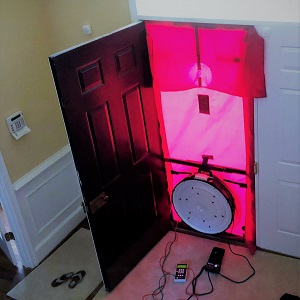
These are all signs that you have had an excellent BGE energy audit!
<Back to Top>
Who is Eligible for a BGE Energy Audit?
 To qualify for the energy audit and participate in the BGE Weatherization Program, you must have an active electric and/or natural gas account with service from BGE.
To qualify for the energy audit and participate in the BGE Weatherization Program, you must have an active electric and/or natural gas account with service from BGE.
The offer is invalid for new construction, multi-family dwellings, or commercial buildings.
UPDATE MARCH 2021: Single-family style duplexes/overlapping townhouses can now participate in Home Performance with ENERGY STAR audits and jobs.
The special $100 fee for the audit is also only valid for your first audit under your BGE account at a specific address.
<Back to Top>
How do you participate in the BGE Energy Audit Program?
According to BGE, the first step in getting an energy audit is to select an approved BGE weatherization contractor. You can schedule a comprehensive home energy audit immediately using our scheduler tool. The cost is $100 ($400 value).
Once the BGE energy audit is complete, your home's data will be entered into the modeling software. The program calculates eligible rebates. It also calculates how much energy you can save if you do the work as prescribed.
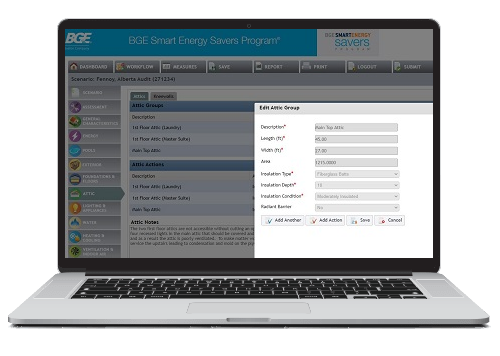
Modeling software generates an accurate and detailed energy report.
<Back to Top>
Incentives and Rebates Connected to the BGE Energy Audit
Are you having a specific comfort or energy usage issue? Are you in the market for insulation, efficient windows and doors, a new water heater, or a new HVAC?
If you said yes, then the BGE energy audit program is an absolute no-brainer for you. Here is what the incentives cover in the way of high-efficiency products and solutions:
- Air Sealing and insulation
- Heating and cooling equipment
- ENERGY STAR® Windows and Doors
- Hybrid heat pump water heaters
- Duct Sealing
- Smart Thermostats
Learn more about how to unlock your BGE Energy Saver Rebates!
<Back to Top>
BGE Energy Audit Instant Savings Measures (Discontinued)
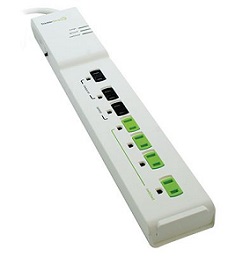 This service is no longer part of a comprehensive home energy audit. You are eligible for a Quick Home Check through BGE. Examples of what you can have installed to help are:
This service is no longer part of a comprehensive home energy audit. You are eligible for a Quick Home Check through BGE. Examples of what you can have installed to help are:
- High-efficiency LED light bulbs
- Low-flow shower head fixtures
- Low-flow sink aerators
- Insulation for water heater pipe
- Smart power strips
<Back to Top>
Can a BGE Energy Audit Help Me Find Ways to Reduce Insects/Rodents In My Home?
An energy audit has one primary purpose: to tighten your home's envelope. This means to let less air leak in or out. Insects travel in and out through the same pathways.
The answer is yes! A BGE energy audit will search your entire home for air leakage. Taking advantage of the available incentives to get the work done will also help reduce pests.
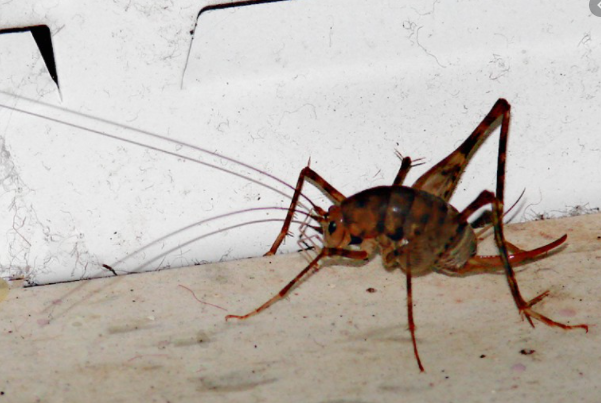
Nature's Moisture Meter. If you have Camel Crickets inside, the humidity is too high.
<Back to Top>
Will the results of a BGE energy audit save you money?
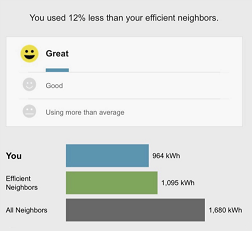
A comprehensive energy assessment through BGE will likely save you money in some way!
Many factors must be in the equation to determine an exact answer.
For example:
- How long will you live in the home?
- How much work does the home need?
- What type of fuel do you use for heating and cooling?
A BGE energy audit is the best way to determine the answer to the $ question. That is the design of the program. The audit is the analysis step. Information obtained during the audit can set a pathway to comfort and efficiency.
<Back to Top>
What Types of Recommendations Can Come Out of a BGE Energy Audit?
If you believe that improving comfort and efficiency is as simple as replacing windows or adding insulation to what you have, then a BGE energy audit is something you should strongly consider. Following building science principles will make great sense after the audit is complete.
Through the BGE weatherization program, a typical prescription for tightening up a house and making it more efficient will include caulking, air sealing, insulation, and special treatment for the attic hatch. Walls accessible in the attic (knee walls) may be recommended for improved treatment, and the basement rim joist is a big opportunity in unfinished areas to seal up the lower regions of the home, which also accounts for energy waste and comfort issues.
Read a Case Study

Each home is different, and the "low-hanging fruit" is different for each home. A good energy auditor will find differences in the same model in the same neighborhood. The audit takes a snapshot of your home's insulation levels around the house, reports on them, and recommends improving the boundary locations.
At the end of the process, you will find out how much insulation costs. You will also begin to understand the different aspects of a properly installed insulation project. Careful planning and attention to detail will make a big difference in the results.
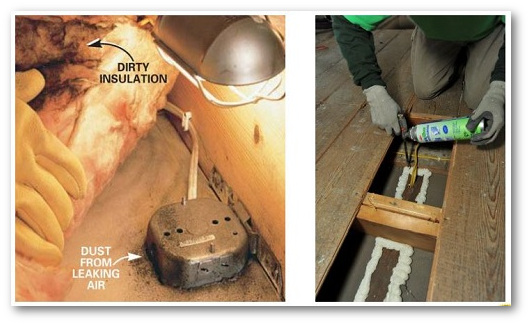
<Back to Top>
Conclusion
Residential homes and commercial buildings account for approximately 39 percent of U.S. energy consumption.
Energy consumption within a building is made up of many parts; the building envelope is the biggest factor in what part of the usage is waste. The envelope serves as the barrier between the inside and outside.
A BGE energy audit evaluates your home's envelope and finds easy ways to tighten things up. A BGE energy audit can lead to more home comfort and smaller energy bills.
________________

Written by Eric Gans
I have over 2000 energy audits under my belt in Maryland. I like to take my personal experiences with each of my audit customers and try to get the things that concern them out into the world so others can make sound home improvement decisions - in the correct order - according to their needs.
Have you had a BGE energy audit, and if so, what was your experience? We want to know!